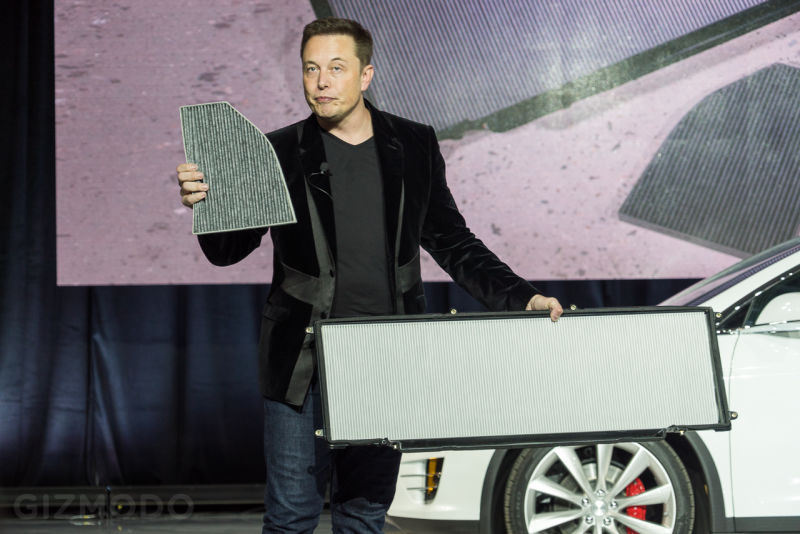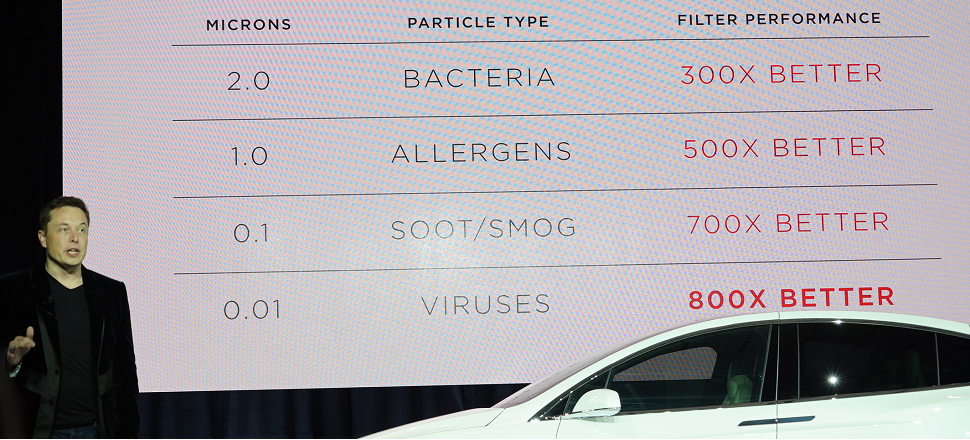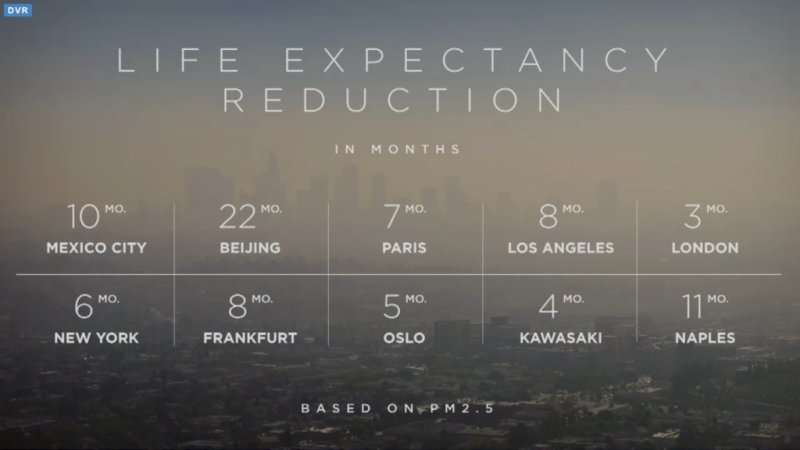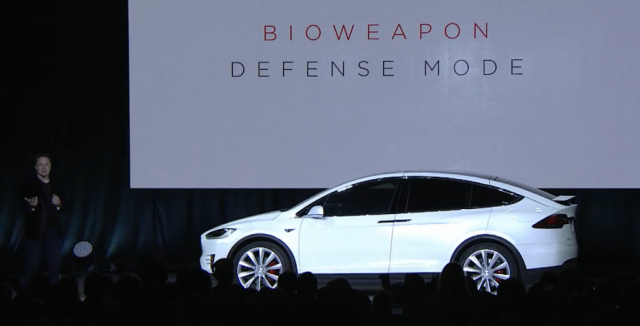The air conditioning system in the new Tesla Model X has three modes: circulating air from outside the car, re-circulating air that’s already inside the cabin, and a “bioweapon defence mode,” triggered by a button on the dashboard, which creates positive pressure inside the cabin to keep outside particles at bay. So, does it work? We asked bioweapons experts for their take on Tesla’s panic button.
Colonel Randall Larsen, retired from the U.S. Air Force and now the director of the Institute for Homeland Security, says he has wanted to buy a Tesla for a long time. “I’m actually building a new house, and I had them put an electrical charger in the garage, just in case I buy a Tesla,” he told me. But when I told him about the Tesla Model X’s “bioweapon defence mode,” he laughed out loud and asked, “So, is Musk actually advertising this?”

Yes, he really is.
Gotta Catch ‘Em All
To be considered a real HEPA filter, an air filter has to remove 99.97% of 0.3 micrometre particles from the air. A 0.3 micrometre HEPA filter is fine enough to catch bacteria like anthrax, which ranges from 1 to 1.2 micrometres across. It will also stop the plague and most other bacteria, as well as most pollen, dust, and fungal spores. HEPA filters also come in a 0.2 micrometre size, but it’s hard to make a filter catch much smaller particles, because that can make it too difficult to push the air through the filter.
“Now, if you’re worried about bacterial agents like anthrax or plague, a good filtering system would probably protect you,” said Larsen.
But viruses are much smaller than bacteria, which means they’re harder to filter out of the air. “Well, 0.3 micrometre won’t hold back viruses. It will hold back most bacteria, but it won’t hold back viruses. So, if you believe that all bioterrorist agents are bacteria, then you’ll get an increment of protection,” said Michael J. Buchmeier, deputy director of the Pacific Southwest Regional Center for Biodefense and Emerging Diseases at the University of California, Irvine.
Smallpox, for instance, is between 200 and 300 nanometres wide, which means it’s right on the edge of a standard HEPA filter’s effectiveness, so — assuming you were driving through a cloud of aerosolised smallpox particles for some reason — it’s possible that some might still get through the filter. And the influenza A virus is 80-120 nanometres wide, so it can pass through even a 0.2 micrometre HEPA filter without a problem. “It’s a statistical game that we play,” said Buchmeier. “Any filter like that is going to be efficient to a degree but it’s not necessarily 100% efficient.”
When he introduced the Tesla Model X to the world, Musk claimed that the car’s HVAC system was 800 times better at filtering out viruses than other cars — and that’s probably true. Plenty of viruses are large enough to get caught by a HEPA filter but small enough to get through an ordinary cabin air filter, so the HEPA system probably does help. The trouble is that there are a lot of viruses out there that it can’t stop, including some with bioweapons potential.

Viruses are really, really small.
Contents Under Pressure
Tesla says its “bioweapon defence mode” also creates positive pressure inside the cabin to protect the car’s occupants. That should keep outside air from entering the SUV’s cabin at all — but the extra air for positive pressurization has to come from somewhere.
Update: As Tesla describes it, “The biodefense button is designed to allow clean medical-grade air into the cabin and keep contaminated air out. When deployed, it pushes the system into full fresh mode, pulling all HVAC air through the HEPA filter. The fan goes to max speed 11, pulling in enough air to slightly pressurize the cabin, keeping other air from entering Model X.”
“So that’s not insignificant, but it doesn’t in itself solve the problem, because you still have to have some way to filter that air,” said Buchmeier.
Another problem is that in order to activate bioweapon defence mode, you have to know there’s been a biological attack nearby — and the first sign of a biological attack might come days or even weeks later when people start showing up at the hospital with symptoms, Larsen pointed out. Unlike radiological “dirty bombs” or even chemical attacks, biological attacks tend to be subtle and hard to detect until it’s too late. “The key problem with the bio is knowing when it’s been released,” he said. “You know, it’s not like there’s a big bang or something.”
By the time symptoms start appearing, it’s a little late to hit a dashboard button. Buchmeier told me, “It’s a pretty extravagant long shot anyway, you know, the idea that you’re going to be forewarned enough to implement this filter in time to prevent any exposure.”

This chart doesn’t include bioterrorist attacks.
Breathe Easier
At the end of the day, “bioweapon defence mode” is probably overkill, anyway. If you’re already in your car, it doesn’t take positive pressurization and HEPA filters to stay reasonably safe, even if there’s a biological attack in your area.
“I first thought about this right after 9/11 when we were just looking for a lot of practical things for people to do, and one of them is, you just push that button that most cars have, that says you stop pulling in outside air,” said Larsen. “I think any good car that has a good seal on the doors and windows and everything, and if you went to the inside air to recycle, I think it’s going to provide you a lot of protection.” That’s not anywhere near the same level of protection as a HEPA filter, of course, but unless you’re right next to a bioweapon when it’s released, it doesn’t really need to be.
In part, that’s because a car in motion passes through a lot of air, and that helps dilute the concentration of any virus particles that might be around the vehicle. “Our protection there is dilution. Think about how much air passes over a car going at highway speed, and how little of that air is actually inhaled by the occupants of the car,” said Buchmeier.
On the other hand, the Tesla Model X’s doomsday-prepper HVAC system does have an everyday feature which might attract some buyers. It could really help filter out allergens like ragweed and cedar pollen, fungal spores like the ones that cause Valley Fever, and irritants like smoke and dust. It could also filter out unpleasant roadside odours, like cattle feed lots or ripe roadkill.
“There are a lot of reasons why you would put a filter like that in, and only one of them is bioterrorism,” said Buchmeier.
